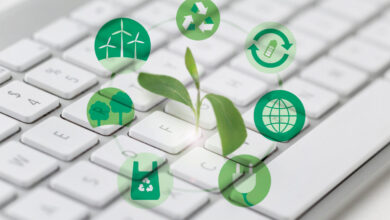Driving Decarbonization in India’s Real Estate Sector: Paving the Way for Sustainable Development

India’s real estate sector finds itself at a pivotal moment, grappling with the twin challenges of rapid urbanization and climate change. As the nation’s second-largest contributor to GDP and a major employer, the real estate industry holds significant sway over India’s economic and social landscape. However, with this influence comes the responsibility to address environmental concerns, particularly the sector’s carbon footprint.
In recent years, there has been a growing acknowledgment of the imperative to decarbonize the global real estate sector. This transition is not merely about adhering to regulatory mandates but also about embracing sustainability as a core tenet of development. In this comprehensive exploration, we delve into the pressing need for decarbonization in India’s real estate sector, draw lessons from international best practices, identify key challenges, and outline strategies for expediting progress.
The Urgency of Decarbonization
The urgency of decarbonizing the real estate sector cannot be overstated. Globally, buildings are responsible for nearly 40% of energy-related carbon dioxide (CO2) emissions, making them a significant contributor to climate change. In India, rapid urbanization, population growth, and escalating demand for housing and infrastructure have exacerbated environmental pressures. According to the International Energy Agency (IEA), India’s energy-related CO2 emissions surged by 50% over the past decade, underscoring the need for immediate action.
The failure to address these emissions not only jeopardizes the environment but also carries profound implications for public health, energy security, and economic stability. Escalating temperatures, extreme weather events, and air pollution are just a few of the visible manifestations of unchecked carbon emissions. Decarbonizing the real estate sector is imperative not only for mitigating climate change but also for fostering healthier, more sustainable communities.
Drawing Insights from Global Best Practices
Several countries have made significant headway in decarbonizing their real estate sectors, offering valuable insights and lessons for India:
- United Kingdom (UK): The UK’s “Net Zero Carbon Buildings Commitment” aims to ensure that all new buildings achieve net-zero carbon emissions by 2030. This ambitious target has catalyzed innovation in building design, energy efficiency, and renewable energy integration. The UK’s experience underscores the importance of setting clear targets and regulatory frameworks to drive decarbonization efforts.
- Denmark: Denmark has emerged as a trailblazer in promoting sustainable construction practices through stringent building codes and incentives. The nation’s focus on energy-efficient buildings, district heating, and renewable energy sources has yielded significant reductions in carbon emissions from the built environment. Denmark’s approach underscores the significance of holistic planning and integrated solutions.
- Singapore: Singapore’s Green Mark certification system has incentivized developers to embrace green building practices. This certification, which evaluates buildings based on their environmental performance, has spurred the proliferation of sustainable buildings across the city-state. Singapore’s experience underscores the pivotal role of market mechanisms and consumer preferences in advancing sustainability.
Challenges and Opportunities in India
Despite the growing awareness and initiatives, several challenges impede decarbonization efforts in India’s real estate sector:
- Lack of Awareness and Capacity: Many developers, architects, and stakeholders lack awareness and expertise in green building practices. Capacity-building initiatives, training programs, and knowledge-sharing platforms are essential to accelerate adoption.
- Cost Considerations: The perceived higher upfront costs of green buildings often deter developers from embracing sustainable solutions. However, studies indicate that the lifecycle costs of green buildings are lower due to energy savings and operational efficiencies.
- Policy and Regulatory Framework: While India has made strides in introducing green building codes and certifications, there is a need for stronger enforcement and incentives. Clear mandates, fiscal incentives, streamlined approval processes, and energy efficiency standards can incentivize developers to prioritize sustainability.
- Technology and Innovation: Embracing advanced technologies such as Building Information Modeling (BIM), energy-efficient HVAC systems, and renewable energy solutions can bolster decarbonization efforts. Collaboration with technology providers and research institutions is crucial for fostering innovation.
Despite these challenges, significant opportunities abound for decarbonizing India’s real estate sector:
- Market Demand: Growing awareness among consumers about environmental issues is driving demand for sustainable homes and offices. Green buildings offer benefits such as energy savings, improved indoor air quality, and enhanced comfort, making them attractive to buyers and tenants.
- Cost Savings: Green buildings not only reduce environmental impact but also yield long-term cost savings. Energy-efficient designs, renewable energy integration, and water conservation measures contribute to financial savings for building owners and occupants.
- Job Creation and Economic Growth: The transition to a low-carbon real estate sector can generate employment opportunities across the value chain. Investments in sustainable infrastructure stimulate economic growth, innovation, and job creation.
Strategies for Accelerating Decarbonization
Realizing decarbonization goals in India’s real estate sector necessitates a multifaceted approach involving collaboration between government, industry stakeholders, and civil society. Key strategies include:
- Policy Support: The government must provide clear policy direction and regulatory incentives for decarbonization. This entails strengthening building codes, offering tax incentives for green buildings, promoting energy efficiency standards, and streamlining approval processes.
- Capacity Building: Training programs, workshops, and certification courses should be offered to developers, architects, engineers, and construction professionals. Building capacity in green building practices and technologies is crucial for widespread adoption.
- Financial Incentives: Access to affordable financing, green loans, and investment incentives can encourage developers to invest in sustainable projects. Financial institutions should offer favorable terms and products for green building initiatives.
- Technology Adoption: Embracing innovative technologies such as the Internet of Things (IoT), artificial intelligence (AI), and renewable energy solutions can enhance building performance and reduce carbon emissions. Collaboration with technology providers and startups can drive innovation in the sector.
- Public Awareness and Engagement: Educating consumers, investors, and policymakers about the benefits of green buildings is vital. Public awareness campaigns, green building showcases, and incentives for sustainable living can foster behavioral change and drive demand for green buildings.
CREDAI-MCHI’s Role in Driving Change
As the apex body of real estate developers, CREDAI-MCHI is at the forefront of driving sustainability within the industry. Our initiatives focus on:
- Policy Advocacy: Engaging with government agencies, policymakers, and regulators to advocate for supportive policies and incentives for green building initiatives.
- Capacity Building: Organizing training programs, workshops, and seminars to educate members about green building practices, technologies, and certifications.
- Collaboration: Partnering with industry experts, technology providers, and research institutions to promote innovation and knowledge sharing.
- Awareness: Raising awareness among consumers, investors, and stakeholders about the benefits of green buildings through campaigns, events, and publications.
A Sustainable Future Awaits
Decarbonizing India’s real estate sector is not just a necessity but an opportunity to foster sustainable growth, innovation, and resilience. By embracing best practices, leveraging technology, fostering collaboration, and empowering stakeholders, we can create a built environment that is environmentally responsible, socially inclusive, and economically viable.
As we navigate the challenges and opportunities of a rapidly changing world, let us embrace sustainability as a guiding principle for development. Together, we can build a brighter and greener future for generations to come.




